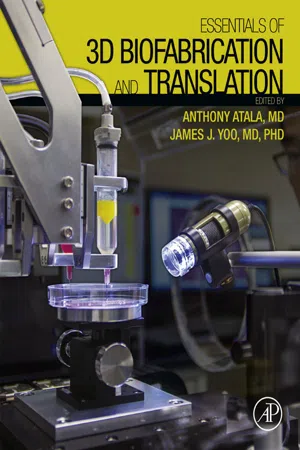
This is a test
- 440 pages
- English
- ePUB (mobile friendly)
- Available on iOS & Android
eBook - ePub
Essentials of 3D Biofabrication and Translation
Book details
Book preview
Table of contents
Citations
About This Book
Essentials of 3D Biofabrication and Translation discusses the techniques that are making bioprinting a viable alternative in regenerative medicine.
The book runs the gamut of topics related to the subject, including hydrogels and polymers, nanotechnology, toxicity testing, and drug screening platforms, also introducing current applications in the cardiac, skeletal, and nervous systems, and organ construction.
Leaders in clinical medicine and translational science provide a global perspective of the transformative nature of this field, including the use of cells, biomaterials, and macromolecules to create basic building blocks of tissues and organs, all of which are driving the field of biofabrication to transform regenerative medicine.
- Provides a new and versatile method to fabricating living tissue
- Discusses future applications for 3D bioprinting technologies, including use in the cardiac, skeletal, and nervous systems, and organ construction
- Describes current approaches and future challenges for translational science
- Runs the gamut of topics related to the subject, from hydrogels and polymers to nanotechnology, toxicity testing, and drug screening platforms
Frequently asked questions
At the moment all of our mobile-responsive ePub books are available to download via the app. Most of our PDFs are also available to download and we're working on making the final remaining ones downloadable now. Learn more here.
Both plans give you full access to the library and all of Perlego’s features. The only differences are the price and subscription period: With the annual plan you’ll save around 30% compared to 12 months on the monthly plan.
We are an online textbook subscription service, where you can get access to an entire online library for less than the price of a single book per month. With over 1 million books across 1000+ topics, we’ve got you covered! Learn more here.
Look out for the read-aloud symbol on your next book to see if you can listen to it. The read-aloud tool reads text aloud for you, highlighting the text as it is being read. You can pause it, speed it up and slow it down. Learn more here.
Yes, you can access Essentials of 3D Biofabrication and Translation by Anthony Atala,James J Yoo in PDF and/or ePUB format, as well as other popular books in Biological Sciences & Biotechnology. We have over one million books available in our catalogue for you to explore.
Information
Chapter 1
Bioprinting Essentials of Cell and Protein Viability
Aleksander Skardal Wake Forest Institute for Regenerative Medicine, Wake Forest School of Medicine, Winston-Salem, NC, USA
Abstract
Bioprinting has emerged in recent years as an attractive method for engineering of 3D tissues and organs in the laboratory, which can subsequently be implemented in a number of regenerative medicine applications. Currently, the primary goals of bioprinting are to (1) create complete replacements for damaged tissues in patients and (2) rapidly fabricate small-sized human-based tissue models or organoids for high-throughput diagnostics, pathology modeling, and drug development. Regardless of which of these end applications are targeted, successful biofabrication using bioprinting technology relies on a set of four essential characteristics that must be optimized. In this chapter, we will discuss and evaluate integration of cell sourcing, biomaterial support, bioprinting device compatibility, and postfabrication tissue support, and how these characteristics are mandatory considerations for practical realization of viable and functional tissue engineered organ and organoid structures.
Keywords
bioprinting
biomaterials
biocompatibility
viability
biofabrication
stability
bioink
cells
hydrogel
1. An introduction to bioprinting
Bioprinting has emerged as a flexible tool in regenerative medicine with potential in a variety of applications. Bioprinting is a relatively new field within biotechnology that can be described as a robotic additive biofabrication that has the potential to build or pattern viable organ-like or tissue structures [1]. In general, bioprinting uses a computer-controlled 3D printing device to accurately deposit cells and biomaterials into precise geometries with the goal being the creation of anatomically correct biological structures. Generally, bioprinting devices have the ability to print cell aggregates, cells encapsulated in hydrogels or viscous fluids, or cell-seeded microcarriers – all of which can be referred to as “bioink” – as well...
Table of contents
- Cover
- Title page
- Table of Contents
- Copyright
- Dedication
- List of Contributors
- Preface
- Chapter 1: Bioprinting Essentials of Cell and Protein Viability
- Chapter 2: Software for Biofabrication
- Chapter 3: Design and Quality Control for Translating 3D-Printed Scaffolds
- Chapter 4: Inkjet Bioprinting
- Chapter 5: In Vivo and In Situ Biofabrication by Laser-Assisted Bioprinting
- Chapter 6: Stereolithographic 3D Bioprinting for Biomedical Applications
- Chapter 7: Extrusion Bioprinting
- Chapter 8: Indirect Rapid Prototyping for Tissue Engineering
- Chapter 9: Bioprinting Using Aqueous Two-Phase System
- Chapter 10: Bioprinting of Organs for Toxicology Testing
- Chapter 11: High Throughput Screening with Biofabrication Platforms
- Chapter 12: Biosensor and Bioprinting
- Chapter 13: Polymers for Bioprinting
- Chapter 14: Hydrogels for 3D Bioprinting Applications
- Chapter 15: Bioprinting of Organoids
- Chapter 16: Bioprinting of Three-Dimensional Tissues and Organ Constructs
- Chapter 17: Bioprinting of Bone
- Chapter 18: Bioprinting of Cartilage: Recent Progress on Bioprinting of Cartilage
- Chapter 19: Biofabrication of Vascular Networks
- Chapter 20: Bioprinting of Blood Vessels
- Chapter 21: Bioprinting of Cardiac Tissues
- Chapter 22: Bioprinting of Skin
- Chapter 23: Bioprinting of Nerve
- Chapter 24: Bioprinting: An Industrial Perspective
- Subject Index